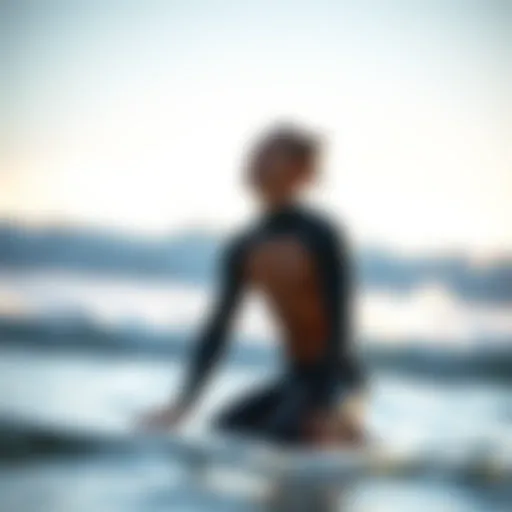Drone Surfing: Merging Tech with Surf Culture
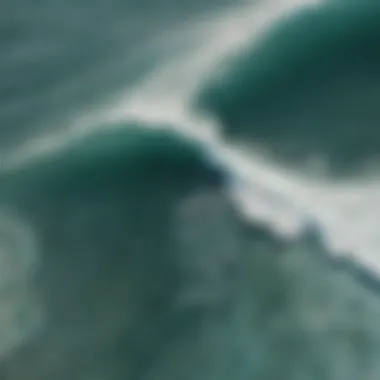

Intro
The sport of surfing has always been about riding the waves and feeling the pulse of the ocean. But as technology rapidly progresses, a novel phenomenon called drone surfing is beginning to merge this age-old sport with contemporary gadgetry. This intriguing intersection invites surfers to explore an enhanced experience, utilizing drones to redefine how they interact with the environment and push their limits.
At its core, drone surfing is not just about the thrill of the ride; it embodies a blend of artistry, precision, and sustainability. Surfers can now harness the power of drones to film breathtaking tricks or monitor ocean conditions more effectively than ever before. Yet the impact of this technology extends well beyond personal enjoyment. The implications touch on critical aspects like safety, sustainability, and the evolution of surf culture itself.
In this article, we’ll delve into the details of this innovative approach, from understanding the latest gear evolution to examining practical skills necessary for maximizing the benefits of drones in real-time surfing scenarios. This voyage will paint a vivid picture of how these flying machines are not merely toys but essential tools in the surf community.
Surf Gear and Equipment
The backbone of any surfer's experience is undoubtedly their equipment. Now, with the advent of drone technology, the gear list has expanded, ushering in a fresh wave of innovations.
Latest Surfboard Technologies
Gone are the days when surfers relied solely on the traditional fiberglass boards. Modern advances have seen the development of surfboards integrated with technology that enhances buoyancy and responsiveness. For instance, boards that feature cork materials offer improved flotation, making them lighter and easier to maneuver. Moreover, some designs now incorporate adjustable fins that can change shape based on wave conditions, giving surfers more control over their ride. Imagine shredding through waves with the board actively adapting to each motion and swell!
Essential Accessories for Surfers
A drone unit isn't all a surfer needs to leap into the surf and sky combination. A handful of accessories can enhance the drone surfing experience:
- Waterproof cases for drones, which prevent damage from ocean water, allowing continuous use without worry.
- Live-streaming capabilities that enable surfers to share their experiences in real time, engaging with a wider audience.
- Foot-mounted camera systems that work hand-in-hand with drones, allowing users to capture their perspective while surfing and feed it back to the drone.
Such accessories not only enrich the experience but also forge a deeper connection between surfers and the enthusiastic community that follows their exploits.
"Embracing technology in surfing doesn’t just transform the sport; it revolutionizes how we perceive our relationship with the waves."
Techniques and Skills
While gear innovation drives many changes, the real artistry lies in the techniques and skills of the surfers themselves. Learning to integrate drones into traditional surfing techniques requires awareness and adaptability.
Wave Riding Strategies
Interpreting wave patterns is crucial for mastering surfing. Drones can provide aerial perspectives, allowing surfers to study the breaks from above, thereby optimizing their approach. This added layer of analysis proves invaluable for both newbies and seasoned surfers alike, as they can identify perfect swells and make informed decisions about their movements.
As surfers become accustomed to drone technology, they often develop unique strategies. For example, the use of drone footage can help in refining one's style. With the ability to analyze specific maneuvers post-session or during competitions, surfers can fine-tune their skills and adjust their techniques for maximum style points.
Safety and Surf Etiquette
As any surfer knows, wave riding comes with its own risks, and safe practices should never be underestimated. Drones can play a vital role here, offering oversight on surf conditions, identifying hazards like riptides, or even locating missing surfers in dire situations.
To maintain a harmonious relationship in the water, surfers need to respect surf etiquette. Integrating drones into the surf culture demands attention to the waves' shared space; annoying others or invading their surfing experience can lead to conflicts. Clear communication and respect for the ocean become paramount as this new technology gains traction among the surf-loving community.
The Rise of Drone Surfing
The emergence of drone surfing marks a pivotal moment in both technological innovation and surf culture. This intersection brings forth a new paradigm where traditional surfing meets modern capabilities, empowering surfers with enhanced tools to engage with the ocean. Understanding this rise involves diving into the historical backdrop, technological advancements, and how drones redefine the surfing experience.
Historical Context
Origins of Surfing
Surfing, a pastime with roots extending back centuries, is as much about culture as it is about riding waves. Originating in ancient Polynesia, surfing was not merely a sport—it was a communal activity steeped in ritual and respect for the ocean. This historical depth provides a rich tapestry that modern drone surfing can draw from. As surfers began to embrace innovations that improved their craft, the allure of integrating technology became clear. The social and environmental fabric of surfing serves as the foundation upon which drone surfing can grow.
The Advent of Drone Technology
The introduction of drone technology in the last decade has been nothing short of a revolution. These unmanned aerial vehicles have transformed diverse sectors, including photography, agriculture, and now surfing. The key characteristic of drones is their ability to provide real-time aerial views of surfers riding the waves. This functionality makes drone technology a compelling choice for enhancing both the safety and skill development of surfers. By capturing high-definition footage, drones allow surfers to analyze their performance in a detailed manner, revealing strengths and weaknesses that may not be visible to the naked eye.
Early Instances of Drone Usage in Surfing
The initial forays into using drones within surfing settings opened several doors for innovation. Early users employed drones primarily for capturing aerial footage. However, these instances laid the groundwork for more complex integrations. The appeal of documenting breathtaking waves captured from above encouraged surfers to explore drone-assisted competitions and training sessions. Notably, this pioneering phase exemplifies how technology can elevate the passionate pursuit of the wave and intertwine it with modern storytelling through visual media.
Technological Advances
Improvements in Drone Design
Over time, drone design has witnessed substantial improvements that cater specifically to the needs of water sports enthusiasts. Recent models have become more lightweight, durable, and water-resistant, all essential for the dynamic environment of surfing. This evolution highlights the benefits of drones being not only portable but also capable of surviving harsh weather conditions. As such, they now provide real-time footage even in challenging scenarios—valuable for both recreational surfers and professionals alike.
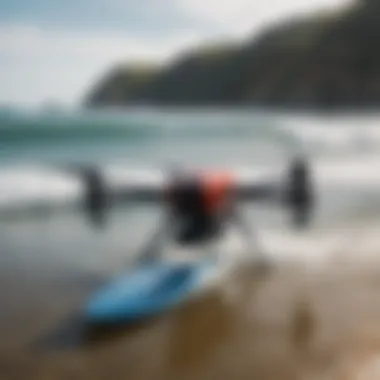

Integration of Camera Technology
The integration of advanced camera technology has revolutionized the capabilities of drone surfing. High-resolution cameras equipped with stabilization features allow for smooth filming despite the often tumultuous conditions of the ocean. This technology serves a dual purpose: it enhances the visual storytelling aspect of surfing, and it aids surfers in skill refinement through analysis of their performance. By offering different perspectives, surfers can see their technique from angles they never considered.
Development of Tracking Systems
Recent advancements in tracking systems have brought yet another layer of sophistication to drone surfing. Real-time tracking helps ensure that the drone remains focused on the surfer, following them as they navigate waves. This feature not only enhances the filming experience but also aids in safety; instructors can monitor their students more efficiently. The unique feature of such systems reinforces the commitment to bringing technology into the surfing realm responsibly and effectively.
Drones have not just altered the view of surfing—they have reshaped how surfers engage with their sport, offering a blend of tradition and modernity that pushes the boundaries of wave riding.
Understanding the Mechanics
Understanding the mechanics of drone surfing is essential for grasping how these two worlds—the technical and the natural—intertwine to create a unique surfing experience. Engaging with this topic unveils not only the advancements in drone technology but also how they can significantly improve surfers' skills and safety. Drones are not just a gimmick; they offer tangible benefits that serve both novice surfers trying to catch their first wave and seasoned surfers looking to refine their techniques.
How Drones Enhance Surfing Techniques
Drone-Assisted Training
Drone-assisted training has taken surfing to a whole new level. Imagine a surfer paddling out while a drone watches from above, capturing every move. This is not just about filming the big stunts; it's about helping surfers break down their performance. The key characteristic here is the bird's-eye view. This perspective allows surfers to see things they can't underwater or while focused on the wave.
A unique feature of drone-assisted training is its ability to provide immediate feedback—surfers can review footage right after their session. The main advantage? It helps in identifying mistakes quickly, fostering quicker improvement. However, the disadvantage could be the occasional distraction; focusing too much on footage might take away from the moment of riding the wave itself.
Real-Time Feedback Mechanisms
Moving further into how these drones reshape the surfing experience, we have real-time feedback mechanisms. This technology allows surfers to receive on-the-spot critique via audio or visual signals. Imagine trying to nail a maneuver while being corrected by a voice from your drone hovering above. This interaction enhances the learning experience significantly.
The hallmark of real-time feedback is its immediacy. Surfers can adjust their techniques as they ride, leading to a dynamic learning atmosphere. While this sounds great, there's a minor issue here: proper calibration of the drone’s sensors is needed to ensure accurate feedback. Thus, while the technology shines in terms of learning speed, any glitch can create confusion during practice.
Video Analysis for Skill Improvement
Next is video analysis for skill improvement. With high-definition cameras mounted on drones, surfers can conduct detailed reviews of their performances. The ability to see every angle of a ride can reveal elements that even the finest athlete might miss during their session.
What sets this apart is the analytical software some setups come with, allowing for slow-motion and frame-by-frame playback. This kind of breakdown can lead to significant advancement in skills, whether it's perfecting balance or timing. The only drawback lies in the fact that this technology requires a certain level of sophistication and can be expensive, making it less accessible for casual surfers.
Safety Features of Drones
Emergency Response Applications
When it comes to safety, drones are being tuned into emergency response tools, especially in surfing locations. The drones can now act as a quick-response unit, relaying information to lifeguards about incidents on the water, essentially functioning like a first-aid navigator.
One notable feature is their ability to carry flotation devices, enabling them to deliver assistance quickly during potential crisis situations. This is a game-changer, as the time saved can often be the difference between a rescue and tragedy. However, there are concerns about overreliance on technology. Not every situation can be handled by a drone, so human intervention remains crucial.
Soaring Visibility for Surfers
The increased visibility offered to surfers through drone surveillance is another marvel. Drones equipped with high-quality cameras can scan vast swathes of ocean, keeping an eye out for potential hazards, such as sharks or other dangerous marine life. This not only assures surfers but also empowers them to make more informed decisions before entering the water.
The defining attribute here is the drone's ability to monitor conditions in real time, offering a clear picture of what awaits out in the waves. Yet, some may argue that, subconsciously, it could heighten fears about the water, leading to nervous surfing experiences—something to consider.
Navigation Assistance in Challenging Conditions
Finally, navigation assistance in challenging conditions is another remarkable aspect of drone technology. In scenarios where visibility is limited—such as foggy mornings or stormy days—drones can send surfers important navigational data. They guide surfers towards safer surf zones and away from rip currents.
The standout feature is the way drones can use GPS and other sensors to provide severe weather updates as well as surf conditions. This level of guidance ensures a safer surfing experience, but the downside is that not all surfers might trust this guidance over their instincts, which have been honed over years of experience.
End
As we delve deeper into understanding the mechanics of drone surfing, it becomes evident that this technology is not merely an accessory but a fundamental aspect reshaping the sport. Through enhancing skills and safety, drones are gradually becoming indispensable tools in modern surfing.
The Drone Surfing Experience
The realm of drone surfing opens a fascinating chapter in the narrative of surf culture. Integrating cutting-edge aerial technology into the age-old art of wave riding not only elevates the experience but also creates new avenues for skill development and community engagement. The presence of drones allows surfers to capture breathtaking footage, analyze their techniques, and foster connections within the surfing community. Through these interactions, the drone surfing experience becomes much more than simply riding waves; it transforms into a multifaceted journey, blending technology, personal growth, and shared passion.
Types of Drones for Surfing
Racing Drones
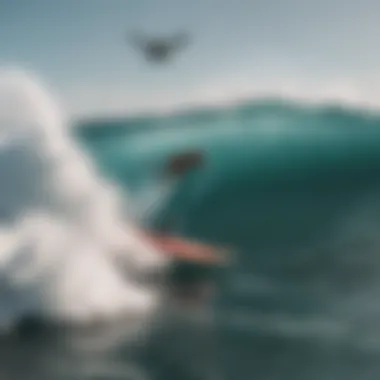

Racing drones play a unique role in drone surfing, especially for those adrenaline seekers who love speed, agility, and technical finesse. These nimble machines are built for rapid maneuvers, enabling surfers to capture high-speed footage while navigating the waves. A standout characteristic of racing drones is their lightweight design, which allows for quick responses and precision when flying. This makes them a popular choice for athletes looking to record their performance from exhilarating vantage points. However, they may lack stability in rough conditions, making for tricky piloting at certain moments.
Camera Drones
Camera drones are perhaps the most well-known variants in drone surfing, offering clarity and detail that enhance the surfing narrative. Their primary feature is high-resolution cameras capable of 4K video quality, which brings the beauty of the ocean and the skill of the surfers to life. These drones are invaluable for capturing stunning overhead shots, offering an unfiltered view of the surfer's journey. Yet, they can be cumbersome in windy conditions and require careful handling to avoid losing footage.
Hybrid Models Combining Both Features
Hybrid models are increasingly gaining attention, merging the swift capabilities of racing drones with the filming prowess of camera drones. These setups cater to diverse streaming needs, fostering creativity in capturing the essence of surfing. A key benefit is versatility; they can swiftly zoom after a wave, then stabilize for a perfect recording. While they provide a balanced experience, one must consider that complexities in operation might pose a learning curve for novice users.
Engagement with Drone Surfing
Training Sessions with Drones
Utilizing drones during training sessions offers surfers a modern twist to traditional learning methods. With immediate aerial footage, surfers can analyze their techniques in real-time, a practice that enhances both skill and awareness. The most critical aspect here is personalized feedback, where athletes can see their performance from angles they wouldn’t normally consider. However, one potential drawback is the pressure of being recorded might distract some surfers.
Competitive Events Integrating Drones
As the integration of drones becomes more mainstream, competitive surfing events have begun to harness their power, bringing a new dimension to contests. These events can offer unprecedented views of athletes as they navigate waves, adding an exciting layer for spectators. A key benefit here is the engagement it fosters, both on-site and through social media, allowing broader exposure for surfers. On the flip side, reliance on technology could overshadow pure athleticism if not managed properly.
Community and Collaborative Efforts
The drone surfing community is increasingly focused on collaboration, with local groups often organizing meet-ups to explore this exciting fusion of surfing and technology together. These initiatives enable surfers of all levels to share knowledge, experiment with different drones, and learn from each other’s experiences. A unique feature of these community efforts is the support network they provide, which often leads to innovations and novel approaches to surfing techniques. Yet, varying levels of experience among members may sometimes create challenges in ensuring all participants fully benefit from these collaborative outings.
The fusion of drone technology and surfing has not only changed the way surfers communicate and connect but has created a new landscape where everyone can participate in the joy and spirit of surfing.
By exploring each of these aspects, it becomes clear that the drone surfing experience is reshaping how we understand surf culture, blending old traditions with new technological possibilities.
Sustainability and Environmental Concerns
In the context of drone surfing, sustainability and environmental concerns emerge as pivotal themes. As surfers blend recreational activity with advanced technology, it becomes essential to consider the ecological footprint of this fusion. The integration of drones offers unique opportunities to monitor and protect marine ecosystems while enhancing the sport itself. Addressing these concerns involves a detailed examination of how drones can be employed for environmental monitoring alongside considering the ethical implications of their use.
Environmental Monitoring Applications
Tracking Marine Life
Tracking marine life using drones has become a game changer in understanding oceanic ecosystems. These drones can efficiently gather crucial data about fish populations and their migratory patterns. This specific aspect contributes significantly to conserving marine biodiversity by enabling researchers and conservationists to track species that are often overlooked. The key characteristic of this application lies in its non-invasive nature, allowing for observation without disturbing marine habitats.
"Drones offer a bird's-eye view of the ocean, revealing secrets below the surface that remain hidden from the human eye."
The unique feature of marine life tracking is its ability to cover vast areas in a short time. This results in comprehensive data collection that is typically not possible through traditional methods. While advantageous, there are disadvantages as well; concerns about noise pollution and disturbances to sensitive species must be acknowledged to implement this tool responsibly.
Assessing Water Quality
Another significant aspect of sustainability in drone surfing is assessing water quality through drone applications. Drones can analyze various water parameters such as temperature, pH, and pollution levels from the air, leading to rapid assessments that help in maintaining healthy surf conditions. This monitoring is beneficial for surfers who are concerned about the water quality’s impact on their health.
The key characteristic of this application is its cost-effectiveness compared to traditional water-testing methods. Using drones can also bring timely data to communities, allowing for quicker reactions to changing conditions. A unique feature of water quality assessment is the integration of sensors that provide real-time data. However, it is essential to ensure that these sensors are sensitive enough to yield accurate results; otherwise, it could lead to misguided decisions regarding water safety.
Measuring Coastal Erosion
Measuring coastal erosion through drone technology is another avenue where drones contribute to environmental sustainability. By capturing high-resolution aerial images over time, they enable scientists to analyze the rate of coastal erosion and its causes, such as climate change and human activity. This aspect is crucial in writing sound coastal management policies.
The prominent characteristic of using drones for measuring coastal erosion is their ability to produce detailed and frequent data collection, making it easier to observe changes over time. Drones provide a unique feature by allowing for visualization in hard-to-reach areas, like cliff sides and remote beaches. However, one downside of this technology lies in the initial costs associated with drone procurement and operation, which may limit access for smaller communities or organizations.
Ethical Considerations
Impact on Wildlife
The impact on wildlife due to drone usage in surfing cannot be overlooked. While drones can aid in tracking and monitoring, they can also cause disturbances to animals. The specific aspect here is understanding how drone activity may affect nesting sites or feeding patterns of local fauna. Opting for quieter drones designed to minimize noise can help mitigate these effects. This is a beneficial choice for promoting a harmonious relationship between technology and the natural world.
One unique consideration is the awareness among surfers and drone operators about wildlife interactions. While technology aims to offer insights, it must be balanced with a commitment to protect these ecosystems.
Regulatory Challenges
Regulatory challenges pose an important aspect of integrating drones into surfing culture. As regulations regarding drone usage vary by region, compliance can be complicated. The specific focus is on understanding these regulations and how they influence not only surfers but also environmental advocates. This choice impacts how drones are deployed near beaches and marine protected areas.
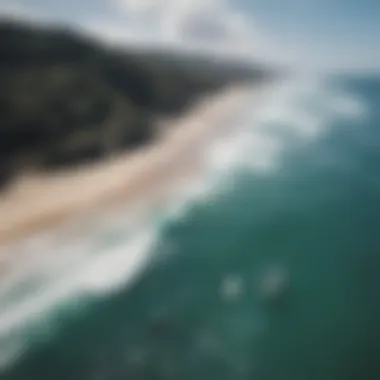

A unique feature of these regulations is the potential for creating designated drone zones to ensure both safety and wildlife preservation. However, the downside is that overly stringent regulations can hinder technological innovation within the sport. Striking a balance between regulation and advancement is crucial for the future of drone surfing.
Community Perspectives on Eco-friendly Practices
Finally, community perspectives on eco-friendly practices highlight the human element in sustainability. Many surf communities are increasingly conscious of their environmental footprint and look to embrace practices that align with sustainable values. The key characteristic of this aspect is the emphasis on collective responsibility, encouraging surfers to be stewards of their environment.
Unique features of these eco-friendly practices often include initiatives for beach clean-ups and advocacy for regulations that benefit both surfers and marine life. However, challenges can arise when there’s a disconnect between technological advancements and community values. Over time, building a community dialogue around these practices can foster understanding and cooperation between surfers and environmentalists alike.
Future of Drone Surfing
The landscape of drone surfing is still in its infancy, yet it's brimming with possibilities. As technology keeps advancing, the future promises a radical transformation in how surfers interact with their environment. This topic is crucial for those intrigued by both surfing and the latest tech trends. One of the essential elements to consider is how innovations, from augmented reality to enhanced drone regulations, can amplify the overall surfing experience. Moreover, the surge of social media means that integrity, accessibility, and context will shape this evolution, requiring a balance between cutting-edge developments and traditional values in surf culture.
Emerging Trends
Augmented and Virtual Reality Integration
Augmented and virtual reality (AR and VR) are two sides of the same coin, both offering immersive experiences that could redefine surfing education and spectator engagement. With AR, surfers can gain real-time insights while riding waves, such as speed, wave height, and even performance metrics directly overlaid in their field of vision. The key characteristic of this integration is its ability to transform learning and practice sessions into interactive and visually stimulating experiences.
One unique aspect of AR technology in surfing is its use in training environments, like simulations that mimic real water scenarios without the risks associated with actual surfing. This has advantages such as enhancing technique and confidence among beginners, but it can also lead to over-reliance on technology if not complemented with practical experience.
Global Influence of Social Media on Drone Surfing
Social media has become the backbone for many trends, including drone surfing. Platforms like Instagram and TikTok are teeming with clips showcasing spectacular drone shots of surfers riding the waves. The primary characteristic here is the massive reach of these visuals, which can launch a surfer's profile into the limelight, thus, drawing interest in drone surfing to the mainstream.
This influence shapes the culture around drone surfing significantly. It can democratize access to knowledge about the sport but also promote unrealistic expectations regarding surfing skills and safety standards, leading some individuals to take unnecessary risks just for the 'gram. The unique feature lies in the way that creativity mixes with competition on these platforms, opening discussions about skill and artistry that might not have been present just a few years ago.
Advancement in Drone Regulations
As the popularity of drone surfing rises, so do the contending issues tied to regulations. The advancement in drone regulations is pivotal because it shapes safe and responsible use in a sport that thrives on thrill-seeking. A key aspect here is creating an official framework that governs the operation of drones in surfing contexts, ensuring that surfers do not infringe upon the rights of others or disrupt marine ecosystems.
A solid regulatory framework encourages the adoption of safety standards and helps cultivate a responsible surfing culture. However, while regulations are necessary, they can be cumbersome and might limit creative drone usage when too restrictive. Striking a balance between innovation and compliance remains an ongoing challenge for the future of drone surfing.
Potential Challenges
Technology Accessibility
Accessibility is crucial in making drone surfing inclusive. Expensive gear can divide the surfing community, limiting participation mainly to those who can afford it. Often, high-quality drones and associated tools come with a hefty price tag, making entry-level options less appealing and effective. By focusing on technology accessibility, the surfing world can expand its horizons, allowing more individuals to experience both surfing and drone technology.
The special feature of ensuring accessibility could be the advent of rental services or community initiatives that lend gear, making it easier for newcomers to engage without breaking the bank. On the downside, if companies prioritize profit over accessibility, the participation gap will widen, potentially compromising the inclusivity that makes the sport vibrant.
Balancing Innovation with Tradition
As innovative technologies infiltrate surfing, a continuous tug-of-war exists between the old and the new. Those who have surfed for years may sometimes view drones as a distraction rather than a tool, favoring the natural experience of riding waves without outside interference. Balancing innovation with tradition is vital to ensure that the essence of surfing remains intact while embracing progress in the sport.
The unique feature is keeping the spirit of surfing alive amidst the hustle of advancements. Still, there’s the risk of alienating traditionalists, causing friction within the community.
Adaptation by Surf Communities
The adaptability of surf communities to new technologies plays a crucial role in the future of drone surfing. Some surfers are swift to embrace the changes and use drones to elevate their experience, while others may resist, preferring to maintain the original surf vibe. Understanding how different communities adapt can provide insights into the broader implications of drone surfing.
What stands out here is the blend of technological integration into local cultures. While this shared knowledge can enhance skill collectively, it can also lead to divisions, with cliques forming that either fully embrace or reject new tech. It’s essential for the conversation to remain open, allowing both sides to respect each other’s perspectives as they navigate this evolving landscape.
Culmination
The exploration of drone surfing embodies a remarkable blend of innovation and tradition, reshaping how surfing is perceived and experienced. In this age where technology is interwoven with our lifestyles, understanding the implications of drone surfing leads us to appreciate its potential benefits and challenges.
Synthesizing Insights
The Future of the Surfing Experience
The future of the surfing experience is poised for a significant transformation as drone technology continues to advance. One standout aspect is the incorporation of augmented reality that can provide surfers with real-time data on wave conditions or safety alerts. This kind of insight enables surfers to make informed decisions while in the water, ultimately enhancing the enjoyment and safety of their time on the waves. Furthermore, the use of drones offers a unique perspective on surfing that traditional filming methods simply cannot match, allowing for a more immersive viewing experience for both surfers and their audiences. However, while embracing these advancements, it will be essential for the surf community to remain grounded in the fundamental essence of surfing—the connection to nature and the ocean.
Continuing the Conversation on Drones in Surfing
Continuing the dialogue on drones in surfing also plays a crucial role in this evolving narrative. As more surfers and enthusiasts adopt drone technology, the need for responsible use becomes paramount. This conversation encourages a culture of respect for ocean environments and fellow surfers alike. One key characteristic of this discussion is the emphasis on community—sharing best practices and innovative techniques fosters collaboration and collective knowledge which can elevate the entire sport. Still, one must navigate the challenges that come with increased visibility in surf zones, ensuring that drones do not infringe on the rights or enjoyment of others.
Encouraging Responsible Surfing Practices
Encouraging responsible surfing practices becomes the backbone of integrating drones into surf culture. This involves promoting an active awareness not just of one’s own impact on the environment but also the environmental implications of drone usage. A unique aspect here is the use of drones for monitoring marine life, which can contribute to conservation efforts. Yet, while drones can serve as tools for ecological awareness, one must tread carefully on privacy and ethical fronts, ensuring that the wild tranquility of surf regions remains undisturbed. Keeping the surf culture eco-conscious while embracing technological advancements aligns seamlessly with today’s environmental ethos, fostering a harmonious coexistence.
In summary, as we surf into this new era of drone technology, balancing innovation with respect for traditions and natural ecosystems will dictate the trajectory of our beloved sport. Promoting meaningful discussions and responsible practices will set the stage for a surf culture that values both advancement and conservation.













